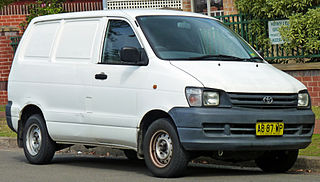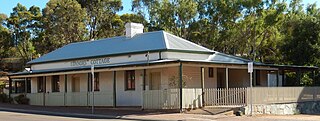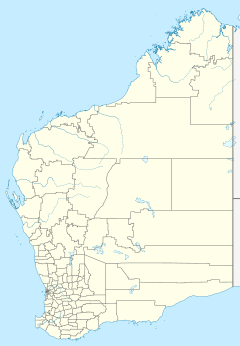
A stationary engine is an engine whose framework does not move. They are used to drive immobile equipment, such as pumps, generators, mills or factory machinery, or cable cars. The term usually refers to large immobile reciprocating engines, principally stationary steam engines and, to some extent, stationary internal combustion engines. Other large immobile power sources, such as steam turbines, gas turbines, and large electric motors, are categorized separately.

Toodyay, known as Newcastle between 1860 and 1910, is a town on the Avon River in the Wheatbelt region of Western Australia, 85 kilometres (53 mi) north-east of Perth on Ballardong Noongar land. The first European settlement occurred in the area in 1836. After flooding in the 1850s, the townsite was moved to its current location in the 1860s. It is connected by railway and road to Perth. During the 1860s, it was home to bushranger Moondyne Joe.

Durrington or High Salvington Windmill is a Grade II listed post mill in High Salvington, Sussex that has been restored and is in full working order. The mill stands 320 feet (98 m) above sea level and is able to take advantage of incoming sea winds.

Sarehole Mill is a Grade II listed water mill, in an area once called Sarehole, on the River Cole in Hall Green, Birmingham, England. It is now run as a museum by the Birmingham Museums Trust. It is known for its association with J. R. R. Tolkien and is one of only two working water mills in Birmingham, with the other being New Hall Mill in Walmley, Sutton Coldfield.

Dunster Working Watermill is a restored 18th century watermill, situated on the River Avill, close to Gallox Bridge, in the grounds of Dunster Castle in Dunster, Somerset, England. It is a Grade II* listed building.

The Toyota LiteAce and TownAce are a line of light commercial and derivative passenger vans produced by the Japanese car manufacturer Toyota. These vehicles originally utilized the cab-over-engine configuration, although since 1996 a semi-cab-over arrangement has featured instead. The LiteAce launched in 1970 as light-duty truck, with commercial and van/wagon body variants added in 1971. In 1976, Toyota released the larger TownAce van/wagon that derived from the LiteAce; a TownAce truck arrived later in 1978. Between 1982 and 1992, the series accommodated the MasterAce Surf—an upscale TownAce passenger wagon.

The Newcastle Gaol Museum is a prison museum on Clinton Street in Toodyay, Western Australia, founded in 1962. The museum records the history of the serial escapee Moondyne Joe and his imprisonment in the "native cell".

Bidborough Mill is a Grade II listed, house converted tower mill west of Bidborough, Kent, England. It is now incorporated into a housing development called Mill Court, on the south side of the B2176 Penshurst Road.

Skidby Windmill is a Grade II* listed windmill at Skidby near Beverley, in the East Riding of Yorkshire, England.

Ifield Water Mill is a 19th-century weatherboarded watermill in the Ifield neighbourhood of Crawley, a town and borough in West Sussex, England. Built on the site of an earlier, smaller flour mill, which itself replaced an iron forge—one of many in the Crawley area—it fell into disuse in the 1930s. The local council, which acquired the land for housing development in the 1970s, leased the mill to local enthusiasts, who restored it to working order. The mill and an associated house are listed buildings, and there is also a cottage on the site.

Butterly House, also known as Monger's Cottage, is located at 1A-D Harper Road, Toodyay, Western Australia. The building was the location of the first bank in Toodyay.

Toodyay Manor on Stirling Terrace was originally the Newcastle Hotel in Toodyay, Western Australia.

Stirling Terrace is the main street of Toodyay, Western Australia, originally called New Road until 1905.

St Stephen's Anglican Church on Stirling Terrace, Toodyay, Western Australia, was one of the earliest significant public buildings constructed in the town then named Newcastle.

Connor's Cottage is situated on Piesse Street in Toodyay, Western Australia.

Clonmoyle Mill was a watermill in the townland of Clonmoyle East, situated 4 km (2.5 mi) south-east of Aghabullogue village and 3.5 km (2.2 mi) north-east of Coachford village.
Charles George Ellery (1854–1937) was Toodyay's bootmaker and was assisted for a time by his brother James, and then his daughter Constance who continued the family business after his death in 1937. His name is associated with his home Shoemaker's House, and shop Ellery's Arcade. He was one of the Toodyay’s civic leaders sitting on a number of boards and committees.

Jonathan Somers was a machinery manufacturer and mayor of Toodyay. He arrived in Toodyay as a blacksmith from Newcastle, New South Wales, and over time built up a major industry manufacturing vehicles and machinery using local timbers. Examples of his work won recognition at the 1899 Western Australian International Mining and Industrial Exhibition, also known as the Coolgardie Exhibition, and in 1900 he won first prize for a wagon at the Glasgow International Exhibition. His contribution to public life led to him becoming the Mayor of Newcastle in 1908. It was largely due to his influence as mayor that the town of Newcastle was renamed Toodyay in 1910.

The Corowa Flour Mill is a heritage-listed former flour mill and now tourist attraction at Steel Street, Corowa, Federation Council, New South Wales, Australia. It is also known as the Corowa Flour Mill and site. It was added to the New South Wales State Heritage Register on 2 April 1999.

The McCrossins Mill is a heritage-listed former mill and store and now museum at Salisbury Street, Uralla, Uralla Shire, New South Wales, Australia. It was designed by John McCrossin and built by Unknown. The property is owned by Uralla Historical Society Inc. It was added to the New South Wales State Heritage Register on 2 April 1999.





















